Abstract
STUDY OBJECTIVE: To compare the use of a non-mortality based proxy for relative needs for healthcare among regional populations with a mortality based proxy for population relative needs and to evaluate the additional value of a proxy based on a combination of non-mortality and mortality based proxies. DESIGN: Analysis of cross sectional data on mortality, socioeconomic status, and self assessments of health taken from registrar general records, a population census, and a population health survey. SETTING: The province of Quebec, Canada. COVERAGE: The populations of the 15 health regions in Quebec. MAIN OUTCOME MEASURE: The levels of correlation of indicators based on mortality data, socioeconomic data, and combined data with a standardised indicator of self assessed health. RESULTS: Variations in scores of a proxy based on socioeconomic data among regions explain 37% of the observed variation in self assessed health, 4% more than the level of variation explained by the standardised mortality rate scores. A weighted combination of both mortality and socioeconomic based proxies explains 56% of variation in self assessed health. CONCLUSIONS: Justification of "deprivation weights" reflecting variations in socioeconomic status among populations should be based on empirical support concerning the performance of such weights as proxies for relative levels of need among populations. The socioeconomic proxy developed in this study provides a closer correlation to the self assessed health of the populations under study than the mortality based proxy. The superior performance of the combined indicator suggests that the development of social deprivation indicators should be viewed as a complement to, as opposed to a substitute for, mortality based measures in needs based resource allocation exercises.
Full text
PDF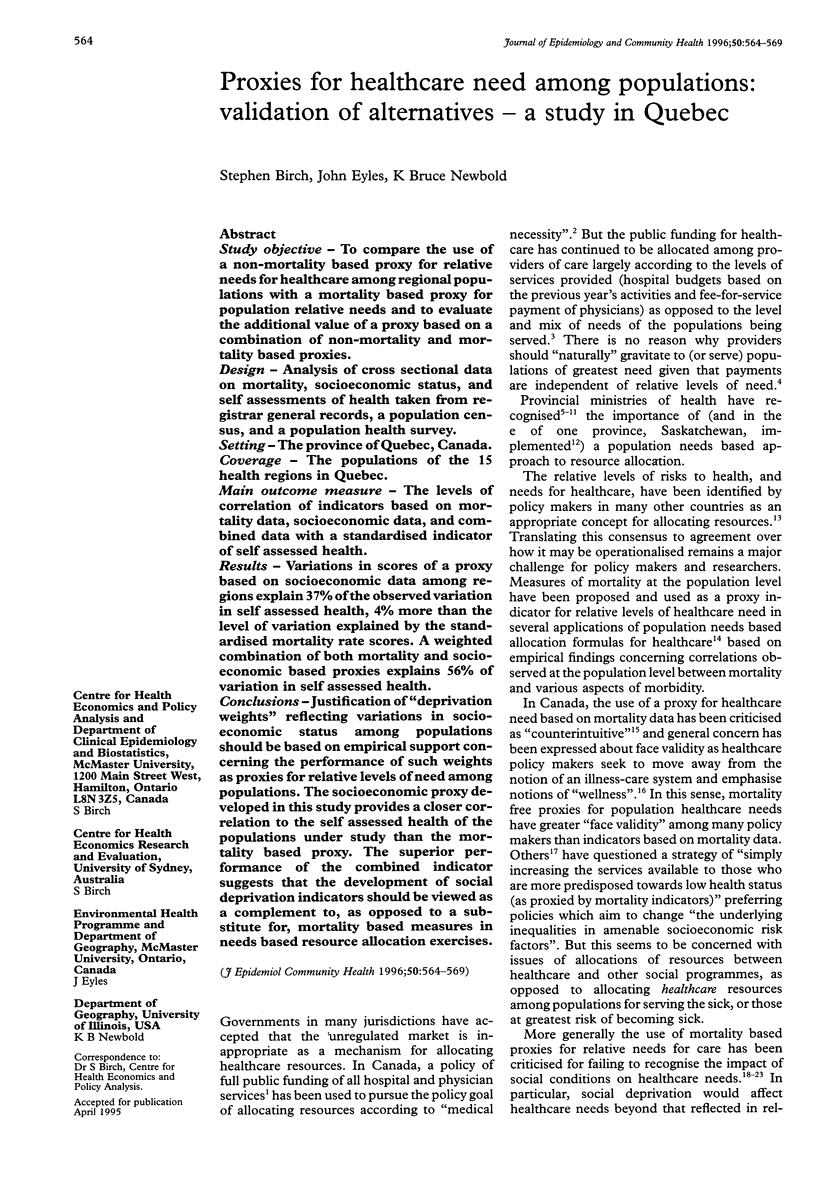
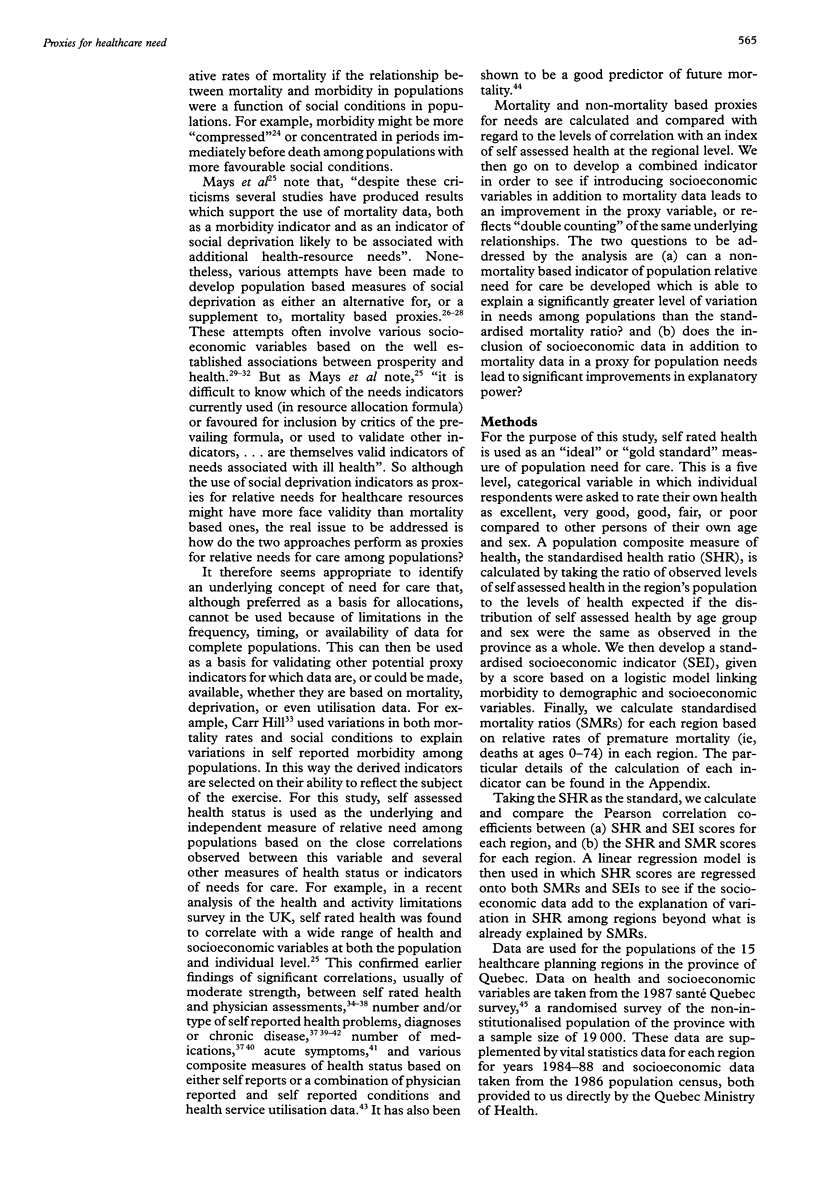
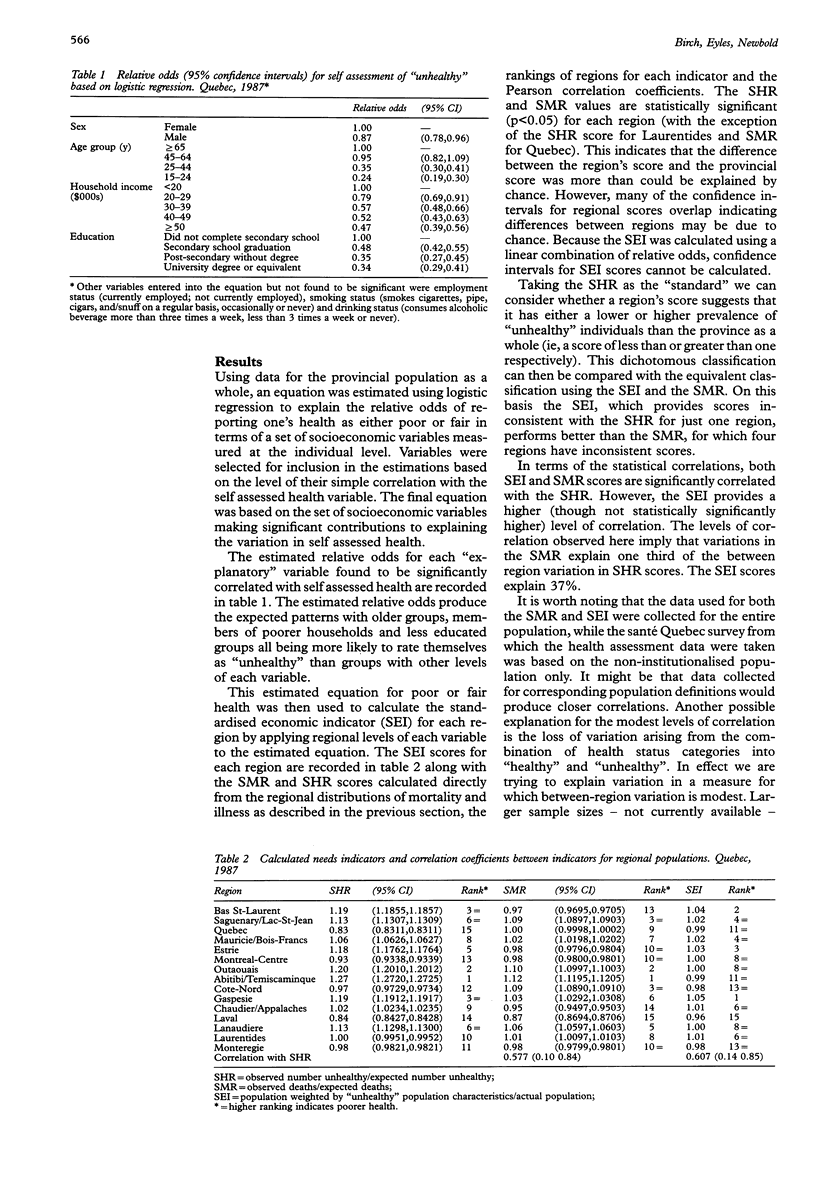
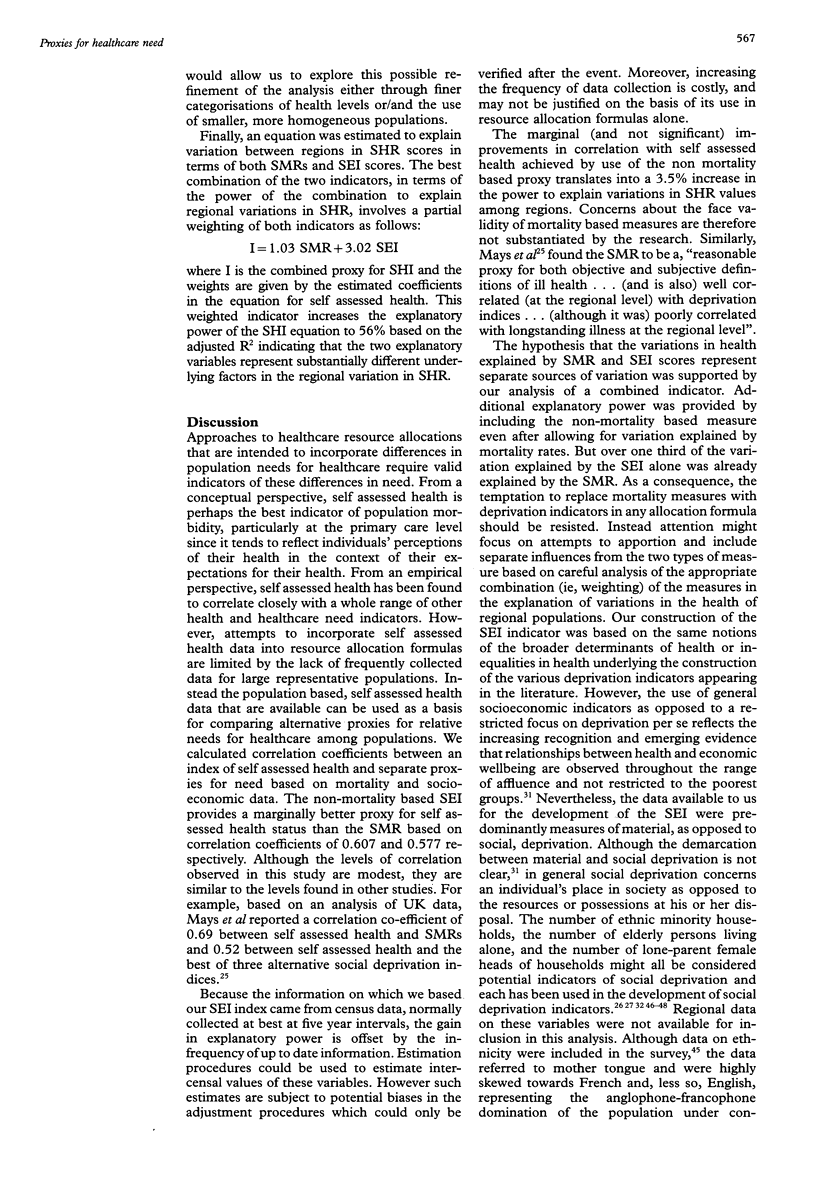
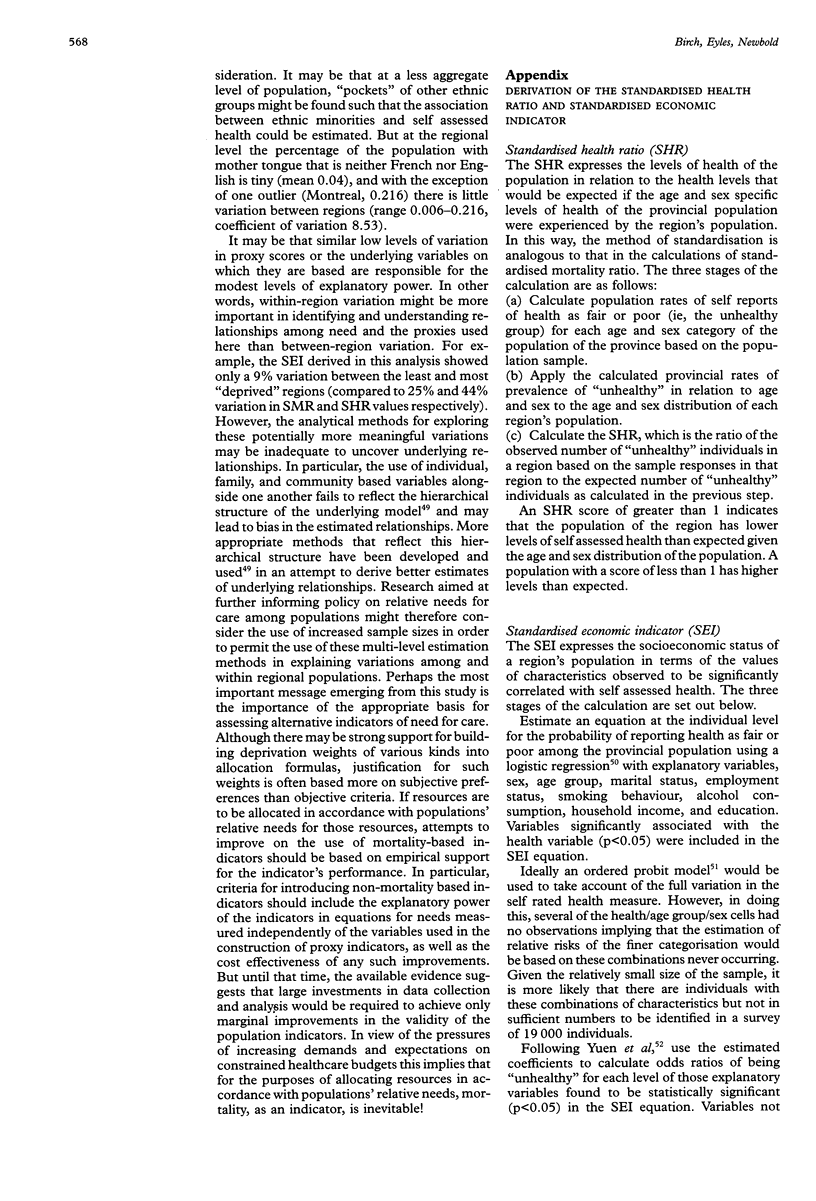
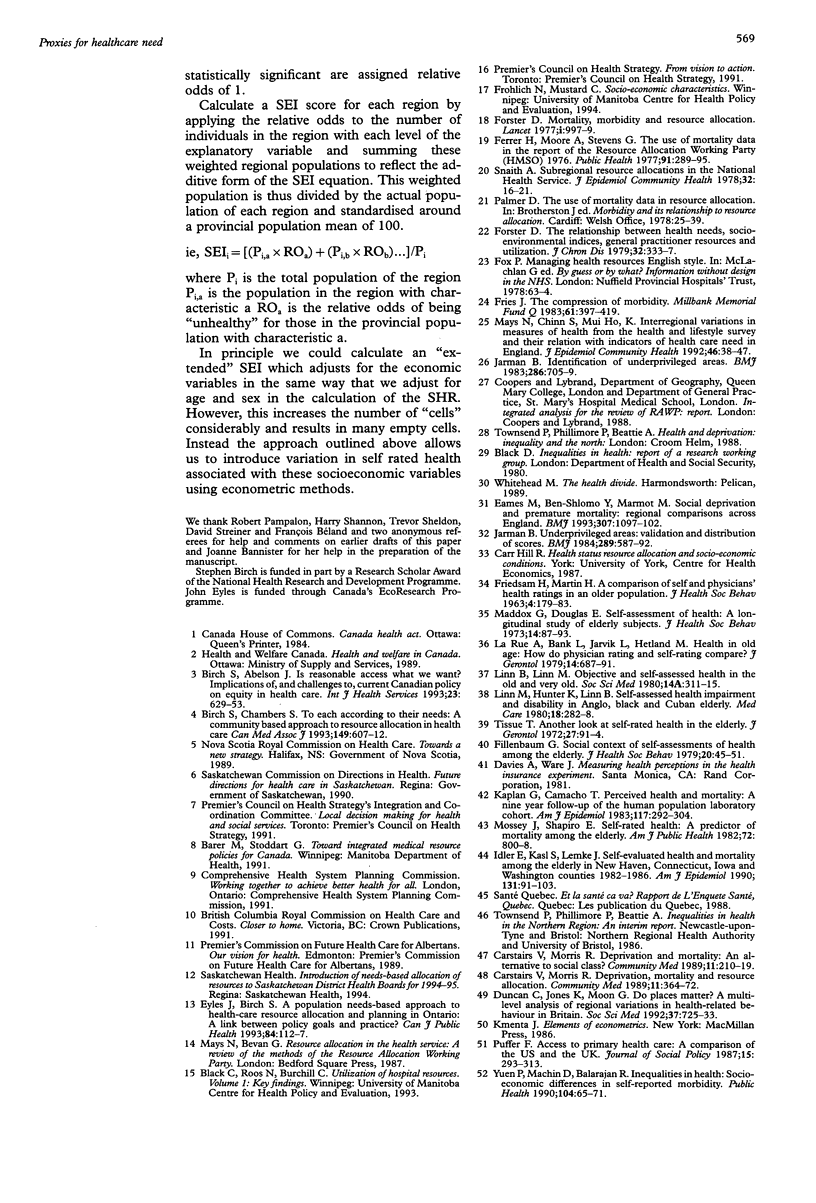
Selected References
These references are in PubMed. This may not be the complete list of references from this article.
- Birch S., Abelson J. Is reasonable access what we want? Implications of, and challenges to, current Canadian policy on equity in health care. Int J Health Serv. 1993;23(4):629–653. doi: 10.2190/K18V-T33F-1VC4-14RM. [DOI] [PubMed] [Google Scholar]
- Birch S., Chambers S. To each according to need: a community-based approach to allocating health care resources. CMAJ. 1993 Sep 1;149(5):607–612. [PMC free article] [PubMed] [Google Scholar]
- Carstairs V., Morris R. Deprivation and mortality: an alternative to social class? Community Med. 1989 Aug;11(3):210–219. doi: 10.1093/oxfordjournals.pubmed.a042469. [DOI] [PubMed] [Google Scholar]
- Carstairs V., Morris R. Deprivation, mortality and resource allocation. Community Med. 1989 Nov;11(4):364–372. [PubMed] [Google Scholar]
- Duncan C., Jones K., Moon G. Do places matter? A multi-level analysis of regional variations in health-related behaviour in Britain. Soc Sci Med. 1993 Sep;37(6):725–733. doi: 10.1016/0277-9536(93)90366-c. [DOI] [PubMed] [Google Scholar]
- Eames M., Ben-Shlomo Y., Marmot M. G. Social deprivation and premature mortality: regional comparison across England. BMJ. 1993 Oct 30;307(6912):1097–1102. doi: 10.1136/bmj.307.6912.1097. [DOI] [PMC free article] [PubMed] [Google Scholar]
- Eyles J., Birch S. A population needs-based approach to health-care resource allocation and planning in Ontario: a link between policy goals and practice? Can J Public Health. 1993 Mar-Apr;84(2):112–117. [PubMed] [Google Scholar]
- Ferrer H. P., Moore A., Stevens G. C. The use of mortality data in the report of the Resource Allocation Working Party (H.M.S.O. 1976). Public Health. 1977 Nov;91(6):289–295. doi: 10.1016/s0033-3506(77)80071-1. [DOI] [PubMed] [Google Scholar]
- Fillenbaum G. G. Social context and self-assessments of health among the elderly. J Health Soc Behav. 1979 Mar;20(1):45–51. [PubMed] [Google Scholar]
- Forster D. P. Mortality, morbidity, and resource allocation. Lancet. 1977 May 7;1(8019):997–998. doi: 10.1016/s0140-6736(77)92291-7. [DOI] [PubMed] [Google Scholar]
- Forster D. P. The relationships between health needs, socio-environmental indices, general practitioner resources and utilisation. J Chronic Dis. 1979;32(4):333–337. doi: 10.1016/0021-9681(79)90089-4. [DOI] [PubMed] [Google Scholar]
- Fries J. F. The compression of morbidity. Milbank Mem Fund Q Health Soc. 1983 Summer;61(3):397–419. [PubMed] [Google Scholar]
- Idler E. L., Kasl S. V., Lemke J. H. Self-evaluated health and mortality among the elderly in New Haven, Connecticut, and Iowa and Washington counties, Iowa, 1982-1986. Am J Epidemiol. 1990 Jan;131(1):91–103. doi: 10.1093/oxfordjournals.aje.a115489. [DOI] [PubMed] [Google Scholar]
- Kaplan G. A., Camacho T. Perceived health and mortality: a nine-year follow-up of the human population laboratory cohort. Am J Epidemiol. 1983 Mar;117(3):292–304. doi: 10.1093/oxfordjournals.aje.a113541. [DOI] [PubMed] [Google Scholar]
- Linn B. S., Linn M. W. Objective and self-assessed health in the old and very old. Soc Sci Med Med Psychol Med Sociol. 1980 Jun;14A(4):311–315. doi: 10.1016/0160-7979(80)90112-5. [DOI] [PubMed] [Google Scholar]
- Linn M. W., Hunter K. I., Linn B. S. Self-assessed health, impairment and disability in anglo, black and cuban elderly. Med Care. 1980 Mar;18(3):282–288. doi: 10.1097/00005650-198003000-00003. [DOI] [PubMed] [Google Scholar]
- Mays N., Chinn S., Ho K. M. Interregional variations in measures of health from the Health and Lifestyle Survey and their relation with indicators of health care need in England. J Epidemiol Community Health. 1992 Feb;46(1):38–47. doi: 10.1136/jech.46.1.38. [DOI] [PMC free article] [PubMed] [Google Scholar]
- Mossey J. M., Shapiro E. Self-rated health: a predictor of mortality among the elderly. Am J Public Health. 1982 Aug;72(8):800–808. doi: 10.2105/ajph.72.8.800. [DOI] [PMC free article] [PubMed] [Google Scholar]
- Puffer F. Access to primary health care: a comparison of the US and the UK. J Soc Policy. 1986 Jul;15(3):293–313. doi: 10.1017/s0047279400015178. [DOI] [PubMed] [Google Scholar]
- Sleep J., Grant A., Garcia J., Elbourne D., Spencer J., Chalmers I. West Berkshire perineal management trial. Br Med J (Clin Res Ed) 1984 Sep 8;289(6445):587–590. doi: 10.1136/bmj.289.6445.587. [DOI] [PMC free article] [PubMed] [Google Scholar]
- Snaith A. H. Subregional resource allocations in the National Health Service. J Epidemiol Community Health. 1978 Mar;32(1):16–21. doi: 10.1136/jech.32.1.16. [DOI] [PMC free article] [PubMed] [Google Scholar]
- Yuen P., Machin D., Balarajan R. Inequalities in health: socioeconomic differences in self-reported morbidity. Public Health. 1990 Jan;104(1):65–71. doi: 10.1016/s0033-3506(05)80347-6. [DOI] [PubMed] [Google Scholar]


